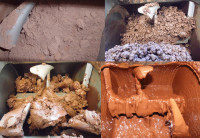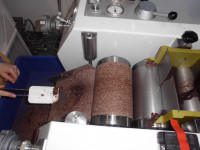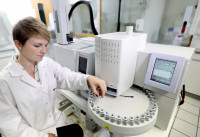Fraunhofer-Institut für Verfahrenstechnik und Verpackung IVV , IVLV - Industrievereinigung für Lebensmitteltechnologie und Verpackung e.V.
Special cocoa & chocolate: Premium chocolate with high cocoa content
Chocolates made from authentic cocoa with high cocoa content are well-established on the market. The premium products have a high consumer expectation which requires know-how about appropriate processing that can lead to novel research. Fraunhofer-Institute for Process Engineering and Packaging IVV and the Industry Association for Food Technology and Packaging (IVLV) advance this technologically challenging process.
By Isabell Rothkopf, Fraunhofer IVV, and Dr Gottfried Ziegleder
Similar to high quality wines, authentic cocoa chocolates are defined by the cultivation region of the cocoa. Such chocolates often contain a high amount of cocoa, with more than 40 % in milk chocolates and 70 to 90 % in dark chocolates. Cocoa from Ghana, Ivory Coast, Nigeria or Indonesia have an intense cocoa taste, whereas fine cocoa from Ecuador, Costa Rica, Nicaragua, Trinidad, Venezuela, Santo Domingo, Madagascar, Grenada, Java, Sri Lanka or Papua New Guinea exhibit additional flavours such as fruity, flowery, nutty, raisin-like, earthy or woody.
Bulk cocoa is known to contain around 600 aroma compounds, with further substances present in fine cocoa that are derived from terpenes and elicit a specific flavouring. These characteristics are more pronounced in chocolate with a higher cocoa content.
Beside the choice of cocoa, the process of conching has a major impact on flavour. Further, mixtures with a cocoa content of more than 70 % cannot be crushed in a five-roll-refiner as is used for conventional chocolates. Therefore, alternative processes are required. This is a specific research topic addressed by the industrial association IVLV and Fraunhofer IVV that encompasses technical plant trials, pre-competitive production experiments, and chemo-sensory assessments of the ensuing products.
Dark bulk chocolate is produced by refining the mixture of cocoa mass and sugar on a five-roll-refiner. The particle size should not exceed 20 µm to avoid a sandy mouth-feel. This is achieved by milling on a roll-refiner. However, during this procedure, particles can agglomerate due to the contact pressure from the rolls, and these agglomerates entrap cocoa butter and lead to a dry consistency of the rolled material. This powder has a high sweetness and a flat taste. During conching, this material is subjected to high mechanical and thermal stresses for several hours. These intense stresses cause the agglomerates to be broken up which releases the entrapped cocoa butter and results in a viscous, pasty mass that requires a high shear for stirring. It is at this stage that the desired homogeneous and intense chocolate flavour is developed. Finally, liquid cocoa butter is added at the end of the conching process to adjust flow properties.
Refining and conching exactly matched
The shear forces exerted in the conche help to develop a harmonized chocolate flavour. Nowadays, it is known that cocoa flavour is adsorbed on the sugar surfaces, thus all of the particles are flavoured and the sweetness of the sugar is covered and drifts into the background. The diffusion of aroma compounds from the cocoa to the sugar surface was first demonstrated analytically at Fraunhofer IVV. The main challenge in this endeavour was, next to detecting trace amounts of aroma compounds, to locate their distribution in the chocolate mass. The flavour of chocolate improves with
increasing energy input and conching time. It is likely that conching promotes the migration of further aroma compounds from within the particles to the particle surface, leading to their distribution throughout the surface. The exact conching process and period differs with manufacturer and is kept a trade secret, but premium chocolates remain in the conche for many hours and are subject to high energy input to achieve the desired flavour of the chocolate.
An increase in cocoa content not only reduces the amount of sugar, but also increases the fat content, since cocoa mass typically contains 54 % of cocoa butter. This high fat content causes rheological difficulties during roller refining. Conventional dark chocolates contain approximately 35 % cocoa mass, 52 % sugar, 12.5 % cocoa butter and 0.5 % lecithin. This leads to a premix of cocoa mass and sugar that contains 21.7 % fat. Chocolate with up to 70 % cocoa content may be made of 60 % cocoa mass, 29.5 % sugar, 10 % cocoa butter and 0.5 % lecithin, resulting in a premix with a fat content of 36.2 %. Mixtures with over 32 % fat, however, are too liquid to refine them on a five-roll-refiner and therefore require alternative processing for refining.
There are three possibilities for refining. Often, the sugar is mixed with only half of the cocoa mass to reduce the fat content. Taking the values stated in the example above, the fat content of a premix made in this manner would be 27.2 %. This mixture can then be processed using a five-roll-refiner with subsequent conching. Using only half of the cocoa mass is sufficient to generate flavour in the sugar of the mass. The remaining half of the cocoa mass can be refined to the desired particle size using a ball mill and then be added to the conched mass. After many hours of conching with high energy input, the second half of the cocoa mass and the cocoa butter is added to finalise the chocolate. This type of processing offers two advantages, namely the development of a fine flavour of the chocolate in the conche and an intensed emphasis on the characteristic cocoa flavour from the briefly-processed cocoa mass.
A second possibility is to use non-alkalised, defatted cocoa powder. To achieve a cocoa content of 70 %, a mixture of 44 % cocoa mass, 11 % cocoa powder, 2 % cocoa butter and 30 % sugar (27 % fat content) can be roller-refined, conched and finalised with the remaining 12.5 % cocoa butter and 0.5 % lecithin. The third process involves the use of a ball mill refiner for the whole cocoa mass, although this leads to a different particle size distribution compared with roller-refined masses.
Literature
Ziegleder G., Balimann G. (2007): Produktion von Bitterschokoladen mit hohem Kakaoanteil. In: Süsswaren 51(3), 21-23, und 51(4), 15-17.
Ziegleder G. (2017): Flavour development in cocoa and chocolate. In: Beckett‘s Industrial Chocolate Manufacture and Use. 5th edition, chapt. 8, 185-215, Wiley Blackwell.



